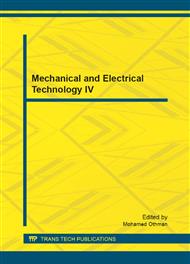p.282
p.287
p.292
p.297
p.303
p.309
p.317
p.321
p.325
Effect of Strain Rate Upsetting Process on Mechanical Behaviour of Epoxy Polymer
Abstract:
The advantages of polymer materials such as high strength and stiffness to weight ratio, corrosion resistance and manufacturing flexibility have increased the industry demands to utilize them in high performance applications. Designing polymer structures depends on a high understanding of their hyper-elastic behaviour, therefore investigating the mechanical behaviour of polymers is necessary. In this paper, the nonlinear behaviour of epoxy polymer is examined under upsetting test. The main aim of the study is to analyse the effect of strain rate on the mechanical behaviour of epoxy polymer. The cylindrical polymer epoxy specimen, 20mm in length and in diameter, was manufactured. The upsetting tests provided quasi-static compressive loads which were adjusted in the loading rates of 0.1, 1, 50, 100, 200 and 500 mm/min. The loadings were continued until complete fracture was observed. Each loading rate was repeated for at least 3 specimens to ensure a reasonably good statistical sampling. The average data of each test is used to produce the load-displacement graphs of the specimens, from which stress-strain curves are extracted to show the behaviour of epoxy polymer. The results show a 37% increase of yield stresses when the loading rate is increased from 0.1 to 500 mm/min and the yield strains increase by 26%. The stress-strain curves are nonlinear where the slope increases when the loading rate is raised from 0.1 to 100 mm/min but then decreases when the rate is further raised from 100 to 500 mm/min. The maximum load that can be sustained is increased with loading rate. This can be due to the microstructure deformation response of epoxy polymer. This polymer is categorised as large-strain material by showing exhibiting large deformations under different rates of compression loading.
Info:
Periodical:
Pages:
303-308
Citation:
Online since:
November 2012
Authors:
Keywords:
Price:
Сopyright:
© 2012 Trans Tech Publications Ltd. All Rights Reserved
Share:
Citation:


